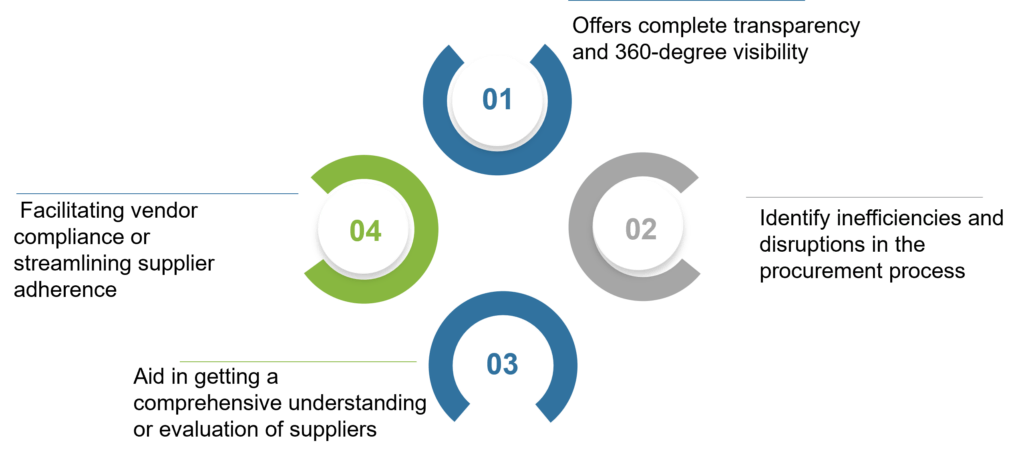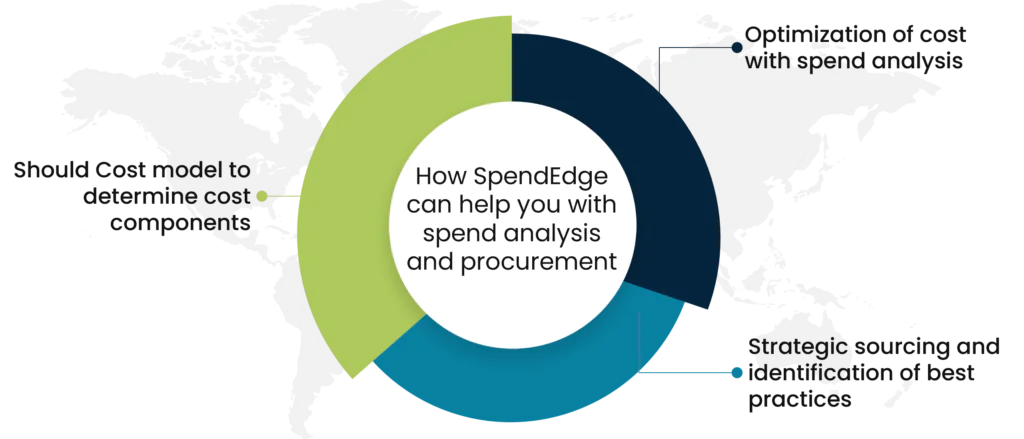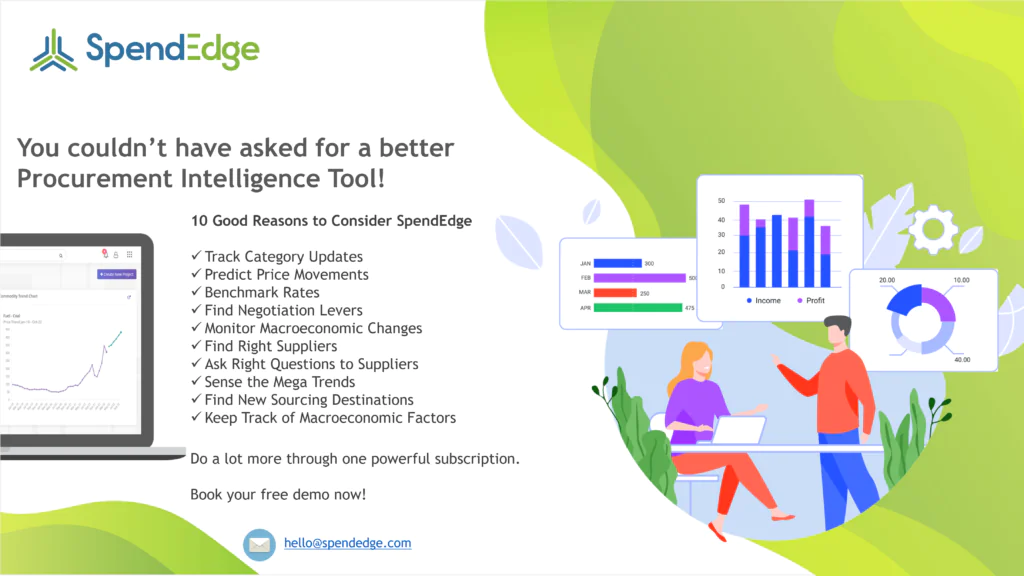By: George Mathew
Table of content
- What is Spend analysis?
- Spend analysis in procurement
- Advantages and benefits of spend analysis
- Conducting spend analysis: Step-by-step process
- How SpendEdge can help you with spend analysis and procurement
- The success story of SpendEdge helping a consumer-packaged goods company
What is Spend analysis?
Spend analysis constitutes a strategic approach aimed at diminishing the cost of a product or service. This practice holds significant importance within procurement, primarily contributing to the reduction of an overall project’s expenses. The primary objective of incorporating spend analysis within procurement lies in the identification of areas where costs are unessential and rectifying these undue expenditures. Enterprises can effectively implement this strategy by optimizing resource allocation, minimizing waste, and enhancing process efficiency.
Spend analysis in procurement
Spend analysis in procurement is the systematic process of examining an organization’s purchasing history, transactions, and expenditures to gain insights into how money is being spent. It involves collecting and analyzing data related to supplier relationships, product categories, and purchasing patterns. This analysis helps procurement professionals make informed decisions to optimize their procurement strategies, reduce costs, and enhance supplier performance.
Spend analysis empowers organizations to identify cost-saving opportunities, negotiate better deals with suppliers, and eliminate inefficiencies in their procurement processes. By gaining a clear understanding of where and how money is being spent, businesses can align their procurement activities with their overall strategic goals. Additionally, in an increasingly competitive business environment, effective spend analysis is a critical tool for achieving cost savings, operational efficiency, and strategic advantage in procurement.
Advantages and benefits of spend analysis

Offers complete transparency and 360-degree visibility:
Spend analysis offers transparency and visibility in an organization’s expenditure, providing invaluable benefits. It enables effective management of expenses by providing a comprehensive view of where and how money is being spent. This visibility aids in identifying and mitigating fraud risks, as irregularities and discrepancies become more apparent. By scrutinizing procurement data, businesses can detect suspicious activities, unauthorized purchases, or supplier overbilling, allowing them to take timely corrective actions. Ultimately, spend analysis enhances financial control, minimizes financial risks, and promotes a culture of accountability and integrity within the organization.
Identify inefficiencies and disruptions in the procurement process:
Spend analysis is a powerful tool in procurement management, offering the crucial advantage of pinpointing inefficiencies within the procurement process. By analyzing historical spending data, organizations can identify areas where resources are being misallocated, costs are inflated, or suppliers are underperforming. This granular insight enables informed decision-making, leading to cost reductions, better negotiation strategies, and optimized supplier relationships. Ultimately, spend analysis not only boosts cost efficiency but also enhances overall procurement effectiveness, helping organizations achieve their financial goals while ensuring the best value for their investments.
Aid in getting a comprehensive understanding or evaluation of suppliers:
Spend analysis can give the advantage of supplier evaluation and comparison, offering a pivotal advantage in understanding and assessing suppliers effectively. By scrutinizing historical spending data, organizations can objectively evaluate the performance of their suppliers. This comprehensive assessment allows for the identification of strengths, weaknesses, and areas for improvement among various suppliers. Furthermore, spend analysis facilitates informed decision-making by providing a data-driven basis for supplier selection and negotiation strategies. Ultimately, it empowers organizations to cultivate and maintain mutually beneficial supplier relationships, optimizing procurement processes, and ensuring that supplier choices align with strategic goals.
Facilitating vendor compliance or streamlining supplier adherence:
Spend analysis significantly benefits organizations by facilitating vendor compliance and effective contract supervision. By systematically examining spending data, it ensures that vendors adhere to the terms and conditions specified in agreements. This proactive approach allows for the early identification of any deviations, enabling swift corrective actions and reducing the risk of contract breaches. Moreover, spend analysis empowers organizations with data-driven insights, enabling more informed and effective negotiations with vendors. Overall, it promotes transparency, minimizes risks, and enhances the overall management of vendor relationships, ultimately contributing to improved procurement efficiency and cost-effectiveness.
Conducting spend analysis: Step-by-step process

Step 1. Identification of Data Sources
The initial step involves obtaining a comprehensive overview of the spend that will be covered. This allows for the restriction of purchases to a select few key sources. Segmentation of spend into different groups facilitates the identification of available spend data sources within departments, plants, and business units. It is important to start by identifying the areas of the business that engage in significant purchases, such as procurement, finance, and marketing.
Step 2. Data Extraction
Once the scope has been narrowed down, the spend data can be captured and consolidated into a centralized database. Given that data is typically available in different formats, languages, and currencies, the process of collecting it into a single source may present challenges.
Step 3. Data Cleansing
The process of cleansing spend data involves identifying inaccuracies, eliminating corrupt records and redundancies, and rectifying errors and discrepancies in descriptions and transactions. This ensures data accuracy and facilitates the identification and removal of incomplete or irrelevant contacts in the database. Typos are rectified, and missing codes are validated and corrected to ensure the availability of up-to-date information.
Step 4. Data Enrichment
Data enrichment entails the enhancement, refinement, and improvement of raw spend data. This process also includes standardizing spend data to facilitate easy viewing. Enriching spend data aims to ensure the accuracy and adherence of all header and line-level names and details to specific naming standards.
Step 5. Classification
Classification typically involves grouping various suppliers belonging to the same parent company or organization. Consolidating diverse spend data into clearly defined categories facilitates the management and addressing of spend across the entire organization. This process involves harmonizing all purchasing transactions to a single taxonomy, allowing procurement to gain visibility of global spending and make informed sourcing decisions. Categorization allows for the grouping of both direct and indirect procurement spend, enabling the analysis and management of similar goods or services.
Step 6. Data Analysis
The final step involves identifying opportunities for savings and other procurement enhancements. Data analysis can address business inquiries such as “What are the best contract deals per supplier?” or “Are buyers purchasing from preferred suppliers?” This process facilitates the identification of opportunities for reducing the number of suppliers per category and negotiating better rates. Furthermore, considering how external data assets can enhance analysis is beneficial. By integrating third-party data into spend analysis, organizations can make more strategic decisions driven by data. This is particularly pertinent in sustainable procurement, where connecting carbon emission data to spend can aid in reducing Scope 3 emissions. Additionally, supplier sustainability scores can contribute to category analysis.
How SpendEdge can help you with spend analysis and procurement

Optimization of cost with spend analysis:
Cost optimization is a critical objective, and SpendEdge excels in achieving it through its expertise in identifying spending patterns and conducting comprehensive spend analysis. Our specialized approach goes beyond surface-level data examination, delving deep into an organization’s spending behavior to uncover valuable insights. By scrutinizing historical expenditure data, we can identify cost-saving opportunities, root out inefficiencies, and recommend strategic actions for our clients. SpendEdge’s precise and data-driven methodologies empower organizations to optimize costs effectively, ultimately enhancing their financial performance and competitive edge in the market.
Strategic sourcing and identification of best practices:
Our approach at SpendEdge goes beyond traditional sourcing methods, employing advanced strategies to optimize supplier relationships, negotiate favorable terms, and enhance procurement processes. With an unwavering commitment to efficiency and value, SpendEdge empowers organizations to achieve sustainable cost reductions, mitigate risks, and stay ahead of market trends. Our strategic sourcing solutions are designed to not only save costs but also enhance overall procurement performance, ultimately contributing to our clients’ competitive advantage in their respective industries.
Should Cost model to determine cost components:
SpendEdge leverages a Should Cost model to provide clients with precise estimations of the expected prices or costs for specific products. Our approach involves a meticulous analysis of various factors, including market dynamics, materials, labor, and production processes. By utilizing this model, we enable our clients to gain a deep understanding of the cost structure associated with their products. This knowledge empowers them to make informed decisions, negotiate effectively with suppliers, and identify opportunities for cost reduction and value enhancement in their procurement processes.
The success story of SpendEdge helping a consumer-packaged goods company
Our client is a prominent US-based Consumer Packaged Goods (CPG) company operating across various countries, that is engaged in the production and distribution of household products.
The company was grappling with mounting procurement costs and a lack of transparency across diverse spending categories. This opacity hindered their capacity to identify opportunities for cost optimization.
Our team of expert advisors at SpendEdge helped the company by conducting a thorough and insightful spend analysis. This deep dive provided us with a comprehensive understanding of the client’s procurement operations. Subsequently, we devised and implemented robust cost optimization strategies, emphasizing standardization in procurement processes and enhancements in inventory management.
The results were amazing, our tailored solutions helped the client achieve substantial cost savings and witnessed a remarkable improvement in profit margins. This success story serves as a testament to SpendEdge’s capability to transform challenges into opportunities, delivering tangible, bottom-line benefits for our clients in the highly competitive CPG industry.

Contact us now to solve your procurement problems!
Author’s Details
George Mathew
Associate Vice President, Sourcing and Procurement Intelligence
George is a procurement specialist at Infiniti Research and provides advisory services to clients across the pharmaceutical, CPG & FMCG, energy, and automotive sectors. He specializes in the procurement areas of industry benchmarking, cost modeling, rate card benchmarking, negotiation advisory, and supplier intelligence.




